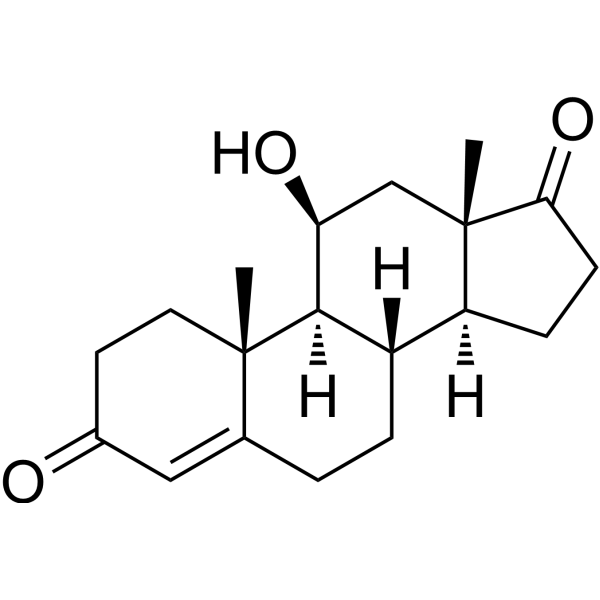
11-Beta-hydroxyandrostenedione
CAS No. 382-44-5
11-Beta-hydroxyandrostenedione( 4-Androsten-11β-ol-3,17-dione | NSC-17102 )
Catalog No. M26588 CAS No. 382-44-5
11-Beta-hydroxyandrostenedione is a steroid mainly found in the adrenal origin (11β-hydroxylase is present in adrenal tissue, but absent in ovarian tissue).
Purity : >98% (HPLC)
 COA
COA
 Datasheet
Datasheet
 HNMR
HNMR
 HPLC
HPLC
 MSDS
MSDS
 Handing Instructions
Handing Instructions
| Size | Price / USD | Stock | Quantity |
| 5MG | 35 | In Stock |


|
| 10MG | 58 | In Stock |


|
| 25MG | 115 | In Stock |


|
| 50MG | 187 | In Stock |


|
| 100MG | 282 | In Stock |


|
| 500MG | 678 | In Stock |


|
| 1G | Get Quote | In Stock |


|
Biological Information
-
Product Name11-Beta-hydroxyandrostenedione
-
NoteResearch use only, not for human use.
-
Brief Description11-Beta-hydroxyandrostenedione is a steroid mainly found in the adrenal origin (11β-hydroxylase is present in adrenal tissue, but absent in ovarian tissue).
-
Description11-Beta-hydroxyandrostenedione is a steroid mainly found in the adrenal origin (11β-hydroxylase is present in adrenal tissue, but absent in ovarian tissue), which is a 11β-hydroxysteroid dehydrogenase isozymes inhibitor. Measuring plasma 11-Beta-hydroxyandrostenedione can distinguish the adrenal or ovarian origin of hyperandrogenism with 4-androstenedione increases.(In Vitro):21-deoxycortisol (21dF) and 21-deoxycortisone (21dE) are assayed within the LNCaP cell line to establish that this conversion is catalyzed by the lyase activity of CYP17A1. After the transfection of CYP17A1, 11-Beta-hydroxyandrostenedione (11OHA4)-pathway metabolites increase, 21dF, and 21dE are in fact metabolized to 11-Beta-hydroxyandrostenedione and 11-ketoprogesterone (11KP4) by CYP17A1, respectively .(In Vivo):In 21-hydroxylase deficiency, Cushing's syndrome, and hyperandrogenism of adrenal origin, the plasma concentration of 11-Beta-hydroxyandrostenedione (11beta-hydroxy-4-androstene-3,17-dione) is very high. In congenital 11-hydroxylase deficiency and adrenal insufficiency, the plasma concentration of 11-Beta-hydroxyandrostenedione (11beta-hydroxy-4-androstene-3,17-dione) is very low. Thus, when plasma 4-androstenedione is elevated, it is useful to measure the plasma 11-Beta-hydroxyandrostenedione level in order to determine the adrenal or ovarian origin of the hyperandrogenism .
-
In VitroIn order to establish that this conversion is catalysed by the lyase activity of CYP17A1, 21-deoxycortisol (21dF) and 21-deoxycortisone (21dE) is assayed within the LNCaP cell line. Upon the transfection of CYP17A1, 11-Beta-hydroxyandrostenedione (11OHA4)-pathway metabolites increase, 21dF and 21dE are in fact metabolised to 11-Beta-hydroxyandrostenedione and 11-ketoprogesterone (11KP4) by CYP17A1, respectively.
-
In VivoThe plasma concentration of 11-Beta-hydroxyandrostenedione (11beta-hydroxy-4-androstene-3,17-dione) is very high in 21-hydroxylase deficiency, Cushing's syndrome, and hyperandrogenism of adrenal origin, and very low in congenital 11-hydroxylase deficiency and adrenal insufficiency. Thus, when plasma 4-androstenedione is elevated, it is useful to measure the plasma 11-Beta-hydroxyandrostenedione level in order to determine the adrenal or ovarian origin of the hyperandrogenism.
-
Synonyms4-Androsten-11β-ol-3,17-dione | NSC-17102
-
PathwayProteasome/Ubiquitin
-
TargetEndogenous Metabolite
-
Recptorα1-adrenergic receptor
-
Research Area——
-
Indication——
Chemical Information
-
CAS Number382-44-5
-
Formula Weight302.414
-
Molecular FormulaC19H26O3
-
Purity>98% (HPLC)
-
SolubilityIn Vitro:?DMSO : 100 mg/mL (330.68 mM)
-
SMILESC[C@]12C[C@H](O)[C@H]3[C@@H](CCC4=CC(=O)CC[C@]34C)[C@@H]1CCC2=O
-
Chemical Name——
Shipping & Storage Information
-
Storage(-20℃)
-
ShippingWith Ice Pack
-
Stability≥ 2 years
Reference
1.Miura, Y. and K. Yoshinaga, Doxazosin: a newly developed, selective alpha 1-inhibitor in the management of patients with pheochromocytoma. Am Heart J, 1988. 116(6 Pt 2): p. 1785-9.
molnova catalog



related products
-
L-Kynurenine
L-Kynurenine is a key intermediate in the breakdown pathway of tryptophan. L-Kynurenine is a substrate of kynureninase KMO and KAT associated with the suppression of antitumor immune responses.
-
Valerylcarnitine
Valerylcarnitine (VALERYL-L-CARNITINE) is a short-chain fatty acid used in the study of type 2 diabetes.
-
2-Acetonaphthone
2-Acetylnaphthalene is a fragrance, anticonvulsant, and antimicrobial agent. It has an onion type flavor and a sulfurous type odor.



 Cart
Cart
 sales@molnova.com
sales@molnova.com


